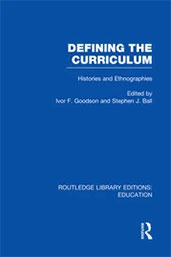Defining the Curriculum: histories and ethnographies
Subjects for Study: towards a social history of curriculum
The use of Layton's work by Young (1977) is a good example of how history is used in this manner. Lay ton was describing a particular movement led by Richard Dawes towards 'The Science of Common Things' and its fate in a particular period during the nineteenth century. Layton was clear that there were striking similarities among many of the issues which engaged science educators in the mid-nineteenth century and those which occupy their latter-day counterparts, but in the first paragraph of his conclusion he warned:
Within the last century and a quarter the social environment of science education has been radically transformed. At the time when Davies and Moseley fought their cause science was a national enterprise of limited scale, operating at the level which Derek Price has termed 'little science'. State and science had not begun to interact in any significant way and the limits of the principles of voluntaryism and laissez-faire applied to the growth of scientific activity, were only just be coming clear. Today, in contrast 'big science' is not only heavily dependent on state patronage, but has become inextricably interwoven into the economic, political and ethical problems of the age. Concomitantly, there has arisen a national system of secular education in which the importance of scientific studies is recognised at all levels. (Layton, 1973, p. 166)
Young, however, uses Lay ton's work to question Professor Jevons' contemporary view that in science 'we are up against something in the cognitive structure of science itself'. A historical snapshot is used to question a view about science today; moreover the implication is that our conceptions of contemporary school science can be understood from evidence of this particular period of conflict. Young is aware that 'it is not possible to draw any direct parallels with science education today' but nonetheless implies if not parallels, direct continuities - 'what is emphasized is the historical emergence and political character of the most basic assumptions of what is now taken to be school science' (Young, 1977, p. 245). In fact, without direct parallels and with no evidence produced of continuities it is difficult to move to any understanding of the basic assumptions of contemporary school science from the specific historical evidence presented from Layton's work.
Clearly the danger of 'raiding' history is that such moves can span centuries of change at all levels of content and context. A more systematic evolutionary understanding of how the curriculum is negotiated is therefore needed. The concern is to ensure that histories make evolutionary connections partly to secure against 'raiding' but more constructively to facilitate the use of such histories in developing theoretical frameworks. A continuity thesis cannot be assumed (as in Young) but has to be established over time. It is surely at the centre of the sociological as well as historical enterprise to examine curriculum transformation and reproduction at work over time: such complex undertakings simply cannot be elucidated by 'snapshots' of unique events which may be entirely aberrant and without general significance. The recurrence of events, however, can help in discerning explanatory frameworks in which structure and interaction interrelate. One is reminded of the humility of Lowe's comment in his seminal article on the divided curriculum:
While it is well known that the major educational enquiries of the mid-nineteenth century culminated in an analysis of the educational needs of society by the Taunton Commissioners which in some ways prefigured [this] twentieth century tripartism, it is not widely realised that the evolution of ideas on a structured and hierarchical system of secondary education was both gradual and continuous from that time. (Lowe, 1976, pp. 139-40)
